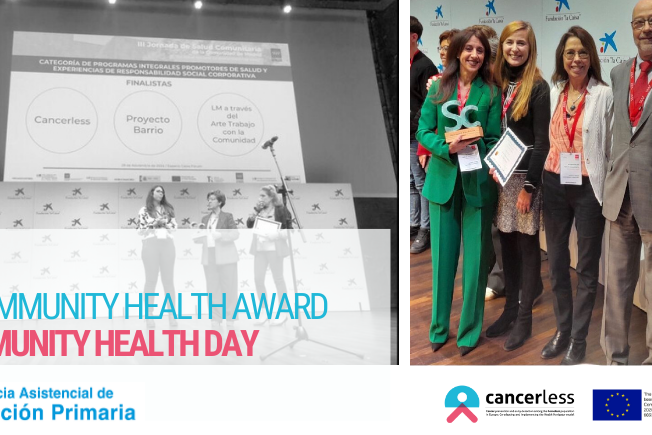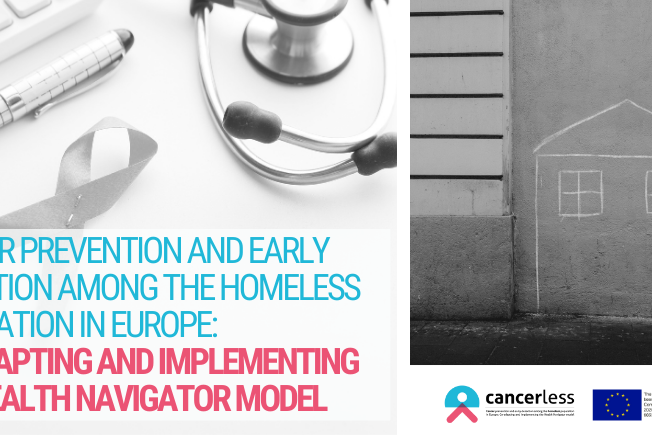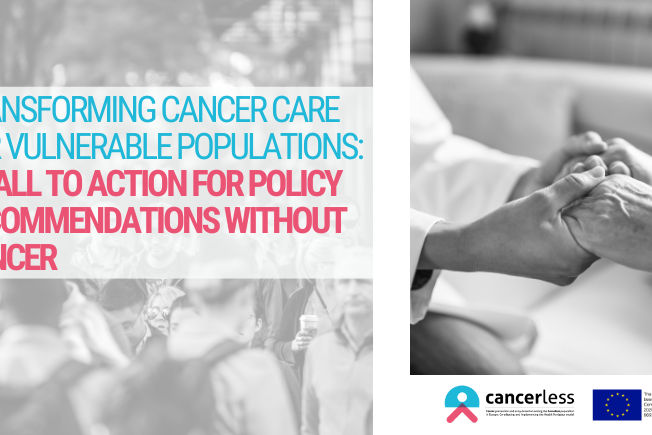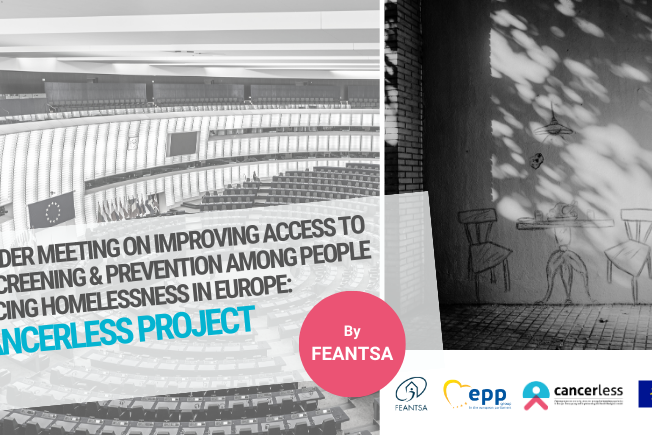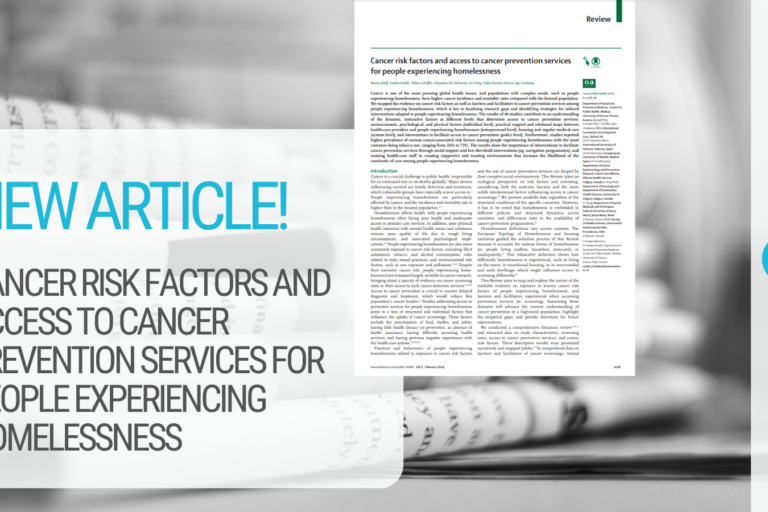Nearly thirty per cent of persons living in homelessness are women and most of them do not have a support system. Whilst women experiencing homelessness are faced with very specific problems, research on their situation is still lacking. Most importantly, decisive actions and policies are required to ensure their appropriate access to healthcare.
Across Europe, we are still confronted with a lack of research and guidelines to unveil the phenomenon of homelessness among women. Studies and guides on homelessness tend to be highly androcentric, leaving homeless women in a situation of invisibility (Fernández-Rasines & Gámez-Ramos, 2013). Whist most people experiencing homelessness are men, roughly 20% – 30% are women and non-binary individuals, depending on the country and socio-cultural structure . This percentage however, is grossly underestimated due to lack of reliable data. In most European countries, a very narrow definition of homelessness is used (which does not recognise hidden forms of homelessness). (Evidence Review).
📢 Meet the speakers for our Housing First & Women webinar.
— FEANTSA (@FEANTSA) March 2, 2022
♀️ Join in on #InternationalWomensDay and discuss how #HousingFirst can ensure to meet the specific needs of women experiencing #homelessness.
✍️ Register here: https://t.co/nZaeD7daNE pic.twitter.com/GNVCROUkyx
The European Commission has found that women are more likely to be found in insecure accommodation or in inadequate housing than roofless. Women also tend to use shelters only when they are in a crisis or they spend shorter periods in specialist centres compared to men, given that services are very often not adapted to their needs. (Commission Staff Working Document, Confronting Homelessness in the European Union, p.9. ) Motherhood, trauma of separation from children, and psycho-emotional suffering and distress are significantly higher among women when compared to males (Maurin et al., 1989). In addition, little is known about interventions and factors able to mediate the impact of these distressful circumstances (Milburn & D’Ercole, 1991).
Among women experiencing homelessness, the mortality rate is severely higher than in the general population. A study conducted in Toronto concluded that mortality is ten times higher than in the general female population. For instance, the mean age at death was 45 years for males and 43 years for females, in rough sleeping situation, in 2018 accordingly to data on the UK. While the mortality rate was not found to be significantly different among men and women experiencing homelessness (Cheung, 2004), women’s experiences and needs are different. Thus, actions to reduce this terrible health disparity are urgently needed and should be designed from a gender-inclusive perspective.
Screening and cancer prevention
Among severely marginalised individuals, significant barriers to cancer screening exist at three levels, namely at healthcare system level, at the level of healthcare institutions and at provider and individual level. Appropriate counselling, destigmatisation, pragmatist explanation of the screening techniques and fear-supportive attitudes by the professionals involved, adequate funding and integration of care are, amongst other things, urgently needed to overcome the effects of the inverse care law on people without secure housing. (Asgary, 2018).
As the CANCERLESS project repeatedly highlighted, cancer among people experiencing homelessness is insufficiently researched and, most importantly, it is inadequately tackled within social and public health policies. The problems regarding cancer are further complicated by comorbidities, dual pathology, and the difficulties in accessing healthcare (Asgary, 2018). Homelessness causing significant damage to the physical and mental wellbeing of women. Women in situation of homelessness have problems with sleeping, finding enough food, keeping clean and are affected by addiction and at risk of on-going violence against women.
Recommendations for promoting and facilitating the screening include: increasing and implementing appropriate data collection methods, the placement of the screening units in places frequently visited or used by the persons in situation of homelessness, a continuous evaluation of the effectiveness and adequacy of screening campaigns targeted to this population and the consideration of housing as the fundamental social factor (Asgary, 2018). All of these must work from a gendered informed perspective: increasing knowledge of health care professionals on the needs and realities of women who experience homelessness and training on gender and trauma informed approaches to better support women’s health.
Housing as a critical determinant of cancer among women
Women experiencing homelessness are considered a particularly vulnerable group suffering from social exclusion, stigma and intersectional acts of violence. Among people experiencing homelessness, women are recognised to have poorer access to potential employment, greater distress and adverse mental health. However, women specific traits such as social attachments, a trend to socialise with peers, and fewer barriers and reluctance for accessing healthcare, among others, can be considered strengths to support their social inclusion process and cancer prevention (Vázquez et al., 2019). Housing is a crucial cancer co-determinant. Social inclusion and health justice must consider the material conditions of existence of all individuals, in particular housing and its role.
📢 @FEANTSA and the @CANCERLESS_EU consortium call on the @EU_Commission to make 'housing situation' one of the inequality dimensions of the EU Cancer Registry.
— FEANTSA (@FEANTSA) February 16, 2022
Read this thread to find out why⬇️#EUCancerPlan #homelessness #healthinequalities pic.twitter.com/HJxYNH9gQN
The CANCERLESS consortium has raised awareness on the importance of housing as a health determinant, particularly in the context of the new initiative implemented by the European Commission to create a common data base to identify trends, disparities and inequalities between Member States and regions under the Cancer Inequalities Registry.
References
Asgary, R. (2018). Cancer screening in the homeless population. The Lancet Oncology, 19(7), e344–e350. https://doi.org/10.1016/S1470-2045(18)30200-6
Cheung, A. M. (2004). Risk of death among homeless women: A cohort study and review of the literature. Canadian Medical Association Journal, 170(8), 1243–1247. https://doi.org/10.1503/cmaj.1031167
Fernández-Rasines, P., & Gámez-Ramos, T. (2013). La invisibilidad de las mujeres sin hogar en España. Revista de Psicología, 22(2), 42. https://doi.org/10.5354/0719-0581.2013.30852
Maurin, J. T., Russell, L., & Memmott, R. J. (1989). An exploration of gender differences among the homeless. Research in Nursing & Health, 12(5), 315–321. https://doi.org/10.1002/nur.4770120507
Milburn, N., & D’Ercole, A. (1991). Homeless women: Moving toward a comprehensive model. American Psychologist, 46(11), 1161–1169. https://doi.org/10.1037/0003-066X.46.11.1161
Vázquez, J. J., Panadero, S., & Pascual, I. (2019). The Particularly Vulnerable Situation of Women Living Homeless in Madrid (Spain). The Spanish Journal of Psychology, 22, E52. https://doi.org/10.1017/sjp.2019.58


